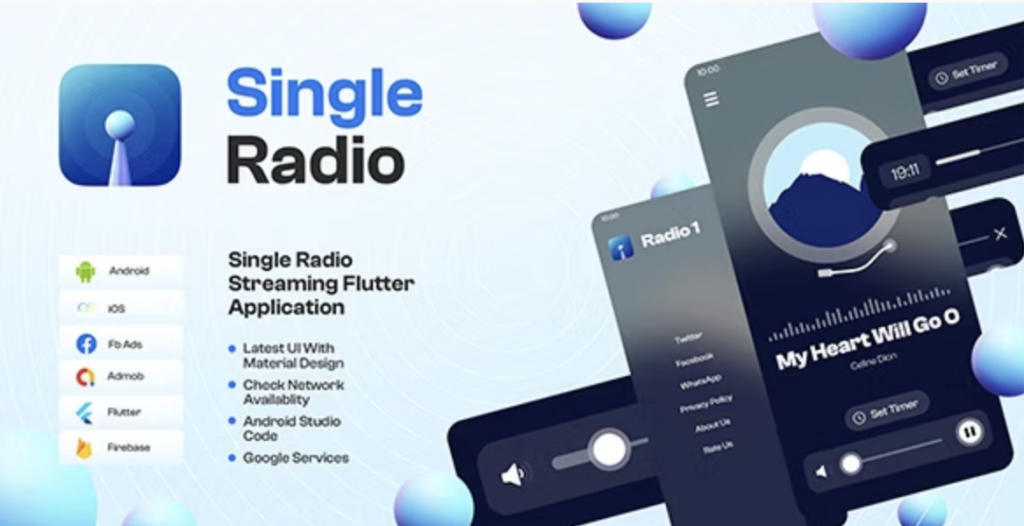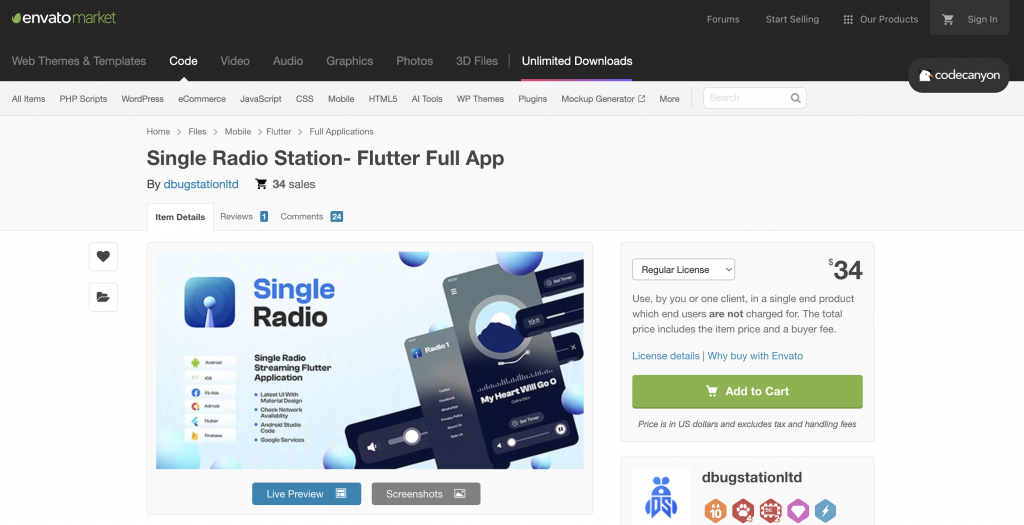The Single Radio Station – Flutter Full App is an exceptional solution for radio streaming, designed specifically for Android devices. With features like SoundCloud playback, live radio online, and Shoutcast radio integration, it provides an unparalleled audio streaming experience. This radio app for Android is perfect for anyone looking to start an online streaming radio station or upgrade their existing setup with advanced sound stream radio capabilities.

Table of Contents
ToggleSingle Radio Station – Flutter Full App
In the fast-paced digital world, staying connected through various media is essential. For radio enthusiasts and station owners, having a reliable and feature-rich app is crucial. The Single Radio Station – Flutter Full App stands out as a comprehensive solution tailored for radio streaming from Android smartphones. This app leverages the power of Flutter, ensuring a smooth and high-performance user experience across all Android devices.
Why Use Single Radio Station Flutter Full App
Choosing the Single Radio Station – Flutter Full App offers numerous benefits. Firstly, it’s designed with user-friendliness in mind, allowing even those with minimal technical knowledge to operate it efficiently. The app supports SoundCloud playback, which means users can easily integrate their SoundCloud playlists and tracks, providing a rich and diverse listening experience.
Moreover, this app excels in live radio online capabilities, enabling real-time broadcasting with minimal latency. This feature is particularly beneficial for broadcasters who want to engage with their audience in real-time, ensuring they don’t miss out on live interactions and immediate feedback.
Another significant advantage is the app’s compatibility with Shoutcast radio. Shoutcast is a popular platform for internet radio broadcasting, and its integration into this app makes it a versatile tool for any broadcaster. Whether you are streaming music, talk shows, or any other type of content, this app handles it all seamlessly.
Single Radio Key Features
The Single Radio Station – Flutter Full App is packed with features that make it a top choice for radio broadcasters:
1. SoundCloud Playback
Integrate your SoundCloud account effortlessly and stream your favorite tracks and playlists directly through the app. This feature broadens the range of content you can offer to your listeners, enhancing their overall experience.
2. Live Radio Online
Broadcast live radio with exceptional quality and minimal latency. Engage with your audience in real-time, providing them with up-to-the-minute content and interactive sessions.
3. Shoutcast Radio Integration
Utilize the power of Shoutcast for your internet radio needs. This app supports Shoutcast streaming, making it a versatile tool for various broadcasting requirements.
4. Radio Streaming from Android Smartphone
Stream high-quality audio directly from your Android smartphone. This feature ensures you can broadcast from anywhere, offering flexibility and convenience to the broadcaster.
5. User-Friendly Interface
The app’s intuitive design makes it easy to navigate and use, even for those who are not tech-savvy. Its clean interface ensures a seamless user experience, keeping the focus on the content.
6. Customizable Themes
Personalize your app with customizable themes. Match the look and feel of the app with your brand’s identity, ensuring a consistent and professional appearance.
7. Push Notifications
Keep your audience informed with push notifications. Alert them about new shows, live sessions, or any updates, ensuring they never miss out on important content.
8. Detailed Analytics
Track your broadcast performance with detailed analytics. Understand your audience better, see what content works best, and refine your strategy accordingly.
9. Multi-Language Support
Reach a global audience with multi-language support. This feature ensures that your app can cater to listeners from different regions, expanding your reach and engagement.
10. Offline Playback
Allow your audience to download and play content offline. This feature is perfect for users who want to enjoy your broadcasts even without an internet connection.
Price
The Single Radio Station – Flutter Full App offers excellent value for money. Priced competitively, it provides a comprehensive suite of features that are typically found in more expensive solutions. Investing in this app ensures you get a robust and reliable platform for your radio broadcasting needs, without breaking the bank.

Conclusion
In conclusion, the Single Radio Station – Flutter Full App is an outstanding choice for anyone looking to start or enhance their radio broadcasting capabilities. With its rich feature set, including SoundCloud playback, live radio online, and Shoutcast radio integration, it stands out as a versatile and powerful tool. Whether you are a seasoned broadcaster or just starting, this app offers the perfect blend of functionality and ease of use. Explore the potential of this app and take your radio station to new heights with seamless radio streaming from your Android smartphone.